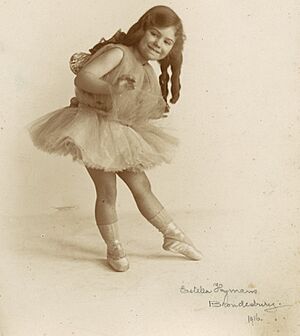Peggy van Praagh facts for kids
Quick facts for kids
Peggy van Praagh
|
|
|---|---|

Peggy van Praagh in "Honey bee dance", 1916 - Estella Hymans
|
|
| Born |
Margaret van Praagh
1 September 1910 London, England
|
| Died | 15 January 1990 (aged 79) Melbourne, Australia
|
| Occupation |
|
Dame Margaret van Praagh (born September 1, 1910, died January 15, 1990) was a very important person in the world of ballet. She was a dancer, created dances, taught, and directed ballet companies. Peggy, as she was known, was British but spent a lot of her career in Australia. She helped shape ballet there.
Contents
Early Life and Education
Peggy van Praagh was born in London, England. Her family had roots in Dutch, Scottish, and English cultures. Her father, Harold John van Praagh, was a doctor. Her mother was Ethel Louise Shanks.
Peggy went to King Alfred School, London. There, she met A. S. Neill, a teacher who encouraged her love for dance. He helped her think creatively about art. This was very helpful for her future in dance. She also took part in many school plays.
Peggy's Dancing Career
Peggy started dancing very early in London, when she was just four years old. People noticed her talent quickly. One newspaper review said she was a "clever little artiste" at age six.
In 1929, Peggy got a short job with a small dance company. This led her to study with famous teachers. She learned ballet from Margaret Craske. She also studied mime, which is acting without words, with Tamara Karsavina. She learned about different dance styles and history.
Dancing with Famous Companies
In 1933, Peggy joined Ballet Rambert, a well-known dance group. Later, she danced with Antony Tudor's London Ballet. She performed in many of Tudor's famous ballets. These included Jardin aux Lilas (also called Lilac Garden) and Dark Elegies.
During World War II, Peggy helped organize special lunchtime ballet shows. These shows were called Ballet for a Bob. They were very popular and attracted many people. In 1941, she joined the Sadler's Wells Ballet. She taught classes and danced in shows like Les Patineurs and Coppelia. In Coppelia, she even danced the main role of Swanilda.
Becoming a Choreographer and Teacher
After the war, in 1945, Peggy became a teacher at the Sadler's Wells Ballet School. She taught there for many years until 1956. During this time, she worked closely with the choreographer Antony Tudor.
From 1956 to 1960, Peggy traveled a lot. She taught dance and produced shows in many countries. These included Germany, Canada, Denmark, and the United States.
Leading Ballet Companies in Australia
In 1959, a famous ballet director suggested Peggy for a new job. She became the Artistic Director of the Borovansky Ballet in Australia in 1960.
When the Borovansky Ballet ended, a new company was formed. It was called the Australian Ballet. Peggy became its first artistic director in 1962. She led the company until 1974. She even came back to help again in 1978. From 1965 to 1974, she shared this role with Sir Robert Helpmann.
Growing the Australian Ballet
Under Peggy's leadership, the Australian Ballet grew a lot. They went on their first international tours. The company performed many classic ballets. They also showed new works by Australian and international choreographers.
Many famous dancers visited and performed with the Australian Ballet. These included Margot Fonteyn and Rudolf Nureyev. Peggy also helped new Australian choreographers develop their skills. Some of these included Graeme Murphy and John Meehan.
Marilyn Rowe, a dancer Peggy mentored, later became a director herself. She shared Peggy's big plan for the Australian Ballet:
- To have dancers on yearly contracts. This was a new idea at the time.
- To perform classic ballets and new works.
- To invite the world's best dancers and teachers.
- To tour the company around the world.
- To create a national ballet school.
Champion for Dance Education
Peggy van Praagh was a strong supporter of dance education. In Australia, she helped organize summer dance schools. These schools had a lasting positive effect on dance in the country.
She also helped start Ausdance. This group helps support and promote dance in Australia. In 1982, Peggy worked at the Western Australian Academy of Performing Arts. She was the coordinator for dance studies there.
Peggy van Praagh passed away in Melbourne on January 15, 1990.
Legacy and Recognition
Peggy van Praagh's contributions to dance are still remembered.
- In 2000, she was added to the Hall of Fame at the Australian Dance Awards.
- In 2001, she was included in the Victorian Honour Roll of Women.
Honours and Awards
- Fellow of the Imperial Society of Teachers of Dancing (London), 1933
- Queen Elizabeth Coronation Prize from the Royal Academy of Dance, 1965
- Officer of the Order of the British Empire (OBE, 1966)
- Member of the Royal Academy of Dancing, 1969
- Dame Commander of the Order of the British Empire (DBE, 1970)
- Britannica Australia Award for Arts, 1970
- Honorary life patron of the National Capital Ballet School, Canberra, 1971
- Hon. D. Litt (University of New England), 1974
- Special Artist's Award, Australia Council, 1975
- Honorary life member of the Australian Ballet Foundation, 1979
- Inducted into the Victorian Honour Roll of Women in 2011
Images for kids


